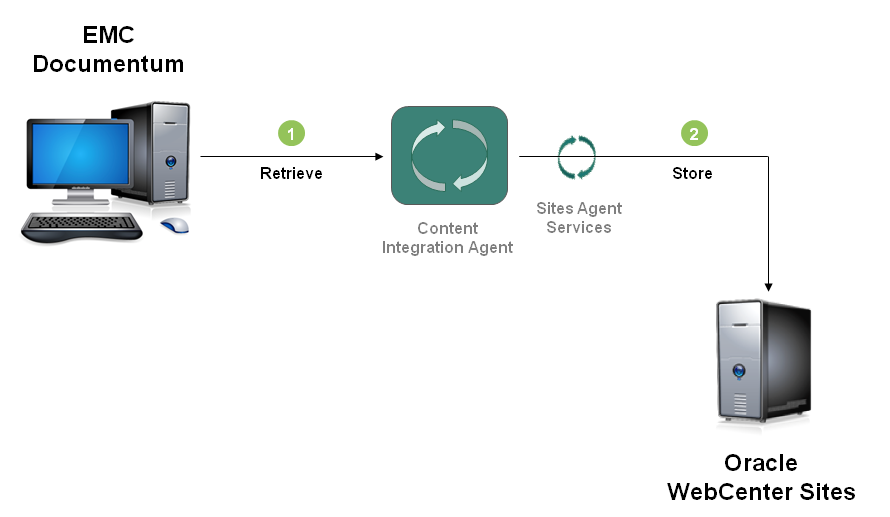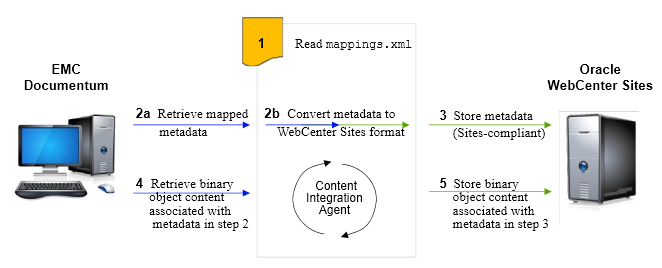62 Publishing to Oracle WebCenter Sites
This chapter provides instructions on publishing from EMC Documentum to Oracle WebCenter Sites.
This chapter contains the following sections:
62.1 Overview of the Publishing Process
Publishing from EMC Documentum to Oracle WebCenter Sites requires the CIP components Content Integration Agent and Sites Agent Services, shown in Figure 62-1, "System Architecture for Publishing to Oracle WebCenter Sites".
Figure 62-1 System Architecture for Publishing to Oracle WebCenter Sites

Description of ''Figure 62-1 System Architecture for Publishing to Oracle WebCenter Sites''
This section contains the following topics:
62.1.1 System Architecture and Process Flow
Content Integration Agent is used to synchronize the source and target workspaces via the cipcommander publish command, the synchronization engine, and the mappings.xml file, which provides the metadata map. Sites Agent Services exposes the web interface used by Content Integration Agent to perform the synchronization process. Following a publishing session, the synchronization process runs automatically. Details of the implementation are described below.
When the cipcommander publish command is issued, the synchronization engine initializes the source and target by replicating metadata and associated content in this manner:
-
The synchronization engine reads the
mappings.xmlfile. -
The synchronization engine refers to the Documentum workspace (that is, cabinet or folder) named in the
cipcommander publishcommand.-
it reads the workspace's objects to retrieve their mapped metadata
-
it converts the metadata to WebCenter Sites-compliant format, using the
mappings.xmlfile
-
-
The synchronization engine stores the WebCenter Sites-compliant metadata to WebCenter Sites (via Sites Agent Services).
-
The synchronization engine retrieves from Documentum the content of binary objects associated with the metadata.
-
The synchronization engine stores the objects (via Sites Agent Services) to the target flex family.
Following the initial synchronization, the synchronization engine starts monitoring the published cabinet or folder and automatically replicates changes to WebCenter Sites (via Sites Agent Services). For example, when an object based on the published metadata is created, modified, or deleted in the monitored cabinet or folder, the synchronization engine replicates the new or modified object, or the object's deletion to WebCenter Sites. If metadata schema is modified, the workspace must be republished.
Content Integration Agent contains a configuration file named catalog.xml, which stores information about the publishing session. Various parameters in the file can be tuned once the synchronization process is initialized. When objects are unpublished, their information is deleted from catalog.xml . For more information about tuning, see Section 62.3.1, "Tuning the Synchronization Process."
62.1.2 Mapping Framework
The CIP mapping framework determines the success of the publishing and synchronization processes. Documentum objects can be published to WebCenter Sites as long as their metadata is mapped. The basic mapping framework for publishing involves two configurable components: the Documentum flex family and the mappings.xml file.
The Documentum flex family, provided with CIP, stores published objects and their object type definitions as WebCenter Sites assets. Chapter 65, "Default Mapping Specifications for Publishing" provides flex family specifications.
For simplicity, we recommend using the default flex family. Should you need to create your own flex family, refer to instructions in the Oracle Fusion Middleware WebCenter Sites Developer's Guide. Use the information in Chapter 65, "Default Mapping Specifications for Publishing" of this guide as a model of the flex family.
The default mappings.xml file contains a documentum2cs section, which specifies the mappings listed below:
-
The
dm_foldertype maps toDocumentum_Folder;dm_folderin theDocumentumflex family, where-
Documentum_Folderis a flex parent asset type that stores folder assets -
dm_folderis a parent definition (of typeDocumentum Parent Definition) that defines the folder type
-
-
The
dm_documenttype maps toDocumentum_Document;dm_documentin theDocumentumflex family, where-
Documentum_Documentis a flex asset type that stores document assets -
dm_documentis a child definition (of typeDocumentum Child Definition) that defines the document type
-
-
Attributes are mapped in the
<descriptor-mapping .../>tags. Attributes are named as listed under the Types node of the Documentum WebTop interface:-
title
-
subject
-
keywords
-
r_version_label
-
r_full_content_size
-
Mapping, Publishing, and Synchronization
When publishing, bear in mind the following mapping specifications:
-
Documentum objects based on default metadata can be published to WebCenter Sites without you having to modify either the default
mappings.xmlfile or theDocumentumflex family. Running thecipcommander publishcommand replicates the specified workspace and its subfolders to theDocumentumflex family as flex parents; documents are replicated as flex child assets. The published workspace is then monitored by the synchronization engine. -
Publishing objects based on custom metadata (such as a new document type) requires you to first update at least the flex family with the new metadata. The
mappings.xmlfile may or may not require updates, depending on the nature of the metadata. Details of custom mappings can be found in Section 62.2.2, "Publishing via Customized Mappings."
62.2 Publishing Procedures
This section contains the following topics:
62.2.1 Publishing via the Default Mapping
In this section, you will publish cabinets and folders to WebCenter Sites using the default mappings.xml file and Documentum flex family.
To publish via the Default Mapping
-
Start Content Integration Agent.
Note:
If you changed the port in the Oracle Fusion Middleware WebCenter Sites Installation Guide, make sure that the new port is set infacilities.xml, and add-p <port>to thecipcommander publishcommand in 3, below (which startsCIPCommander). -
Run the
CIPCommanderexecutable (located in thebinfolder of the system where Content Integration Agent is installed). -
Publish objects of the types that are specified in the default
mappings.xmlfile (for definitions of publishing parameters, see the table Table 62-1, "Publishing Parameters"):cipcommanderpublish <source_providerid> <target_providerid>-source_repname <cabinet_name>-source_path <path_in_cabinet>-target_repname <CS_content_management_site>-mapping <mapping_id>-replic_mode <full | new | updated>-bulk_resynch_interval <seconds>
Examples:
-
To publish the
Imagescabinet to the CIPDemo content management site:cipcommander publish d7a96a63-e78c-407c-8d7f-e84988806e49 70b1e307-26a1-499c-9295-cf0b6bd01342-source_repname Images-source_path / -target_repname CIPDemo-mapping documentum2cs
-
To publish the
/Sample/Treesfolder in theImagescabinet to the CIPDemo content management site:cipcommander publish d7a96a63-e78c-407c-8d7f-e84988806e49 70b1e307-26a1-499c-9295-cf0b6bd01342-source_repname Images-source_path /Sample/Trees-target_repname CIPDemo-mapping documentum2cs
-
-
When the publishing session ends, the synchronization engine starts monitoring the published object.
Verify that modifications and deletions are replicated to WebCenter Sites (for example, modify the replicated objects, add folders and documents to the monitored object, and delete documents).
Objects can also be unpublished. For information, see Section 62.3.2, "Unpublishing."
To optimize the synchronization process, see Section 62.3.1, "Tuning the Synchronization Process."
Table 62-1 Publishing Parameters
Publishing Parameter Required Value <source_providerid>R
Provider ID for Documentum:
d7a96a63-e78c-407c-8d7f-e84988806e49<target_providerid>R
Provider ID for WebCenter Sites:
70b1e307-26a1-499c-9295-cf0b6bd01342-source_repnameR
<cabinet_name>:Name of the cabinet containing the objects to be published. Enter the name exactly as it appears in the URL.-source_path<path_in_cabinet>:Path to the object you want to publish.-
/
(to publish the cabinet specified by
<source_repname>)-
/<folder>/<folder>/... /<folder>
(to publish the last folder in the path)
-target_repnameR
Name of the content management site (on WebCenter Sites) on which the target flex family is enabled. Enter the site's display name, exactly as it appears on the Admin tab in the WebCenter Sites Advanced interface.
-mappingR
<mapping_id>:Value of themapping idinmappings.xml. The value isdocumentum2cs.-replic_modefull | new | updated-
fullmeans that a full replication will be performed (by default), i.e., newly created items, updated items, and deletions. -
newmeans that only newly created items will be replicated (updates and deletions will not be replicated). -
updatedmeans that only new and updated items will be replicated (deletions will not be replicated).
-bulk_resynch_interval<seconds>:Number of seconds between two successive synchronization events.Default value:600For optimal performance, set the synchronization interval to a value that agrees with the frequency of updates to the monitored folders. For more information, see Section 62.3.1, "Tuning the Synchronization Process."
-
62.2.2 Publishing via Customized Mappings
If the objects you plan to publish are based on unmapped metadata, you must first map the object types.
To publish via customized mappings
-
Depending on which type of metadata you have created, update the relevant mapping components as shown below. (We suggest reusing the
Documentumflex family. Themappings.xmlfile is located on the Content Integration Agent host).New Metadata Update Guidelines New folder type Documentumflex familyCreate a parent definition for the new folder type. (The default parent definition is dm_folder.)New folder type mappings.xmlMap the new folder type ( source id). Thetarget idtakes the valueDocumentum_Parent;<parent definition>(whereDocumentum_Parentdefines the storage table for folder assets).New document type Documentumflex familyCreate a child definition for the new document type. (The default child definition is dm_document.)New document type mappings.xmlMap the new folder type ( source id). Thetarget idtakes the valueDocumentum_Child;<child definition>(whereDocumentum_Parentdefines the storage table for folder assets).New document attribute Documentumflex familyAdd the new attribute to the Documentum flex family. New document attribute mappings.xmlMapping the new attribute is required only if its name differs on the source and target. Note: Incorrect mapping of attributes does not stop the publication process, but it does produce a warning message and an entry in the log file.
-
If you create flex filters, add the corresponding
jarfiles to both the WebCenter Sites and the Sites Agent Services applications. -
Publish the objects. For instructions, see Section 62.2, "Publishing Procedures."
62.3 Maintaining the Integrated Systems
This section contains the following topics:
62.3.1 Tuning the Synchronization Process
When a cabinet or folder is published, catalog.xml is updated with data points from the cipcommander publish command. The data points identify the Documentum and WebCenter Sites systems (in the <workspace> tags) and specify replication settings (in the <replication> tag).
Following a publishing session, the synchronization engine monitors the published cabinet (folder), using catalog.xml . The BulkResynchInterval and ReplicMode parameters listed in the sample file below can be reset as shown in Table 62-1, "Publishing Parameters" (The catalog.xml file is located in the conf folder on the Content Integration Agent server).
<workspace id="41ce3f11-0411-46cb-b974-429162249462">
<provider-ref refid="d7a96a63-e78c-407c-8d7f-e84988806e49" />
<init-params>
<param name="repname">Documents</param>
<param name="path">/Images</param>
<param name="repid">0c000001800045fe</param>
<param name="itemid">0b0000018002c58e</param>
</init-params>
</workspace>
<workspace id="6af59904-c6a3-4588-af7b-76f1422d6c10">
<provider-ref refid="70b1e307-26a1-499c-9295-cf0b6bd01342" />
<init-params>
<param name="repname">FirstSiteII</param>
<param name="repid">68ef906a-6c59-406a-84c2-b73b098cdb93</param>
</init-params>
</workspace>
<replication>
<link id="332e73c8-e977-4ba4-85c2-d7636281e192">
<source-ref refid="41ce3f11-0411-46cb-b974-429162249462" />
<target-ref refid="6af59904-c6a3-4588-af7b-76f1422d6c10" />
<mapping-ref refid="documentum2cs" />
<init-params>
<param name="BulkResynchInterval">600</param>
<param name="ReplicMode">full</param>
<param name="IncrementalSyncDelay">10</param>
</init-params>
</link>
</replication>
62.3.2 Unpublishing
You can unpublish objects from catalog.xml and WebCenter Sites by executing the cipcommander unpublish command. The command clears catalog.xml of all entries that are associated with published objects (for a sample publication entry, see the sample file in "Sample catalog.xml"). The -delete parameter removes the same entries from WebCenter Sites' database.
The unpublish command takes the following form and parameters:
cipcommander unpublish <parameters>
Table 62-2 Unpublish Parameters
| Unpublish Parameter | Description |
|---|---|
|
|
Clears |
|
|
Clears
|
|
|
Removes from WebCenter Sites' database the same objects that you are unpublishing from Legal values: Default value: |
